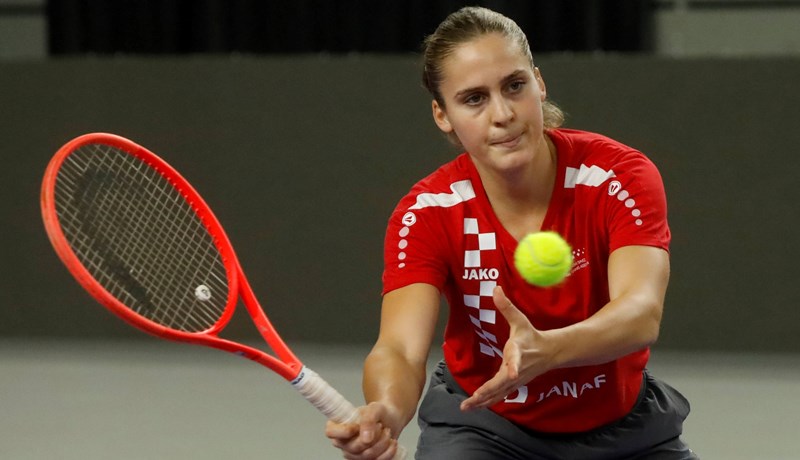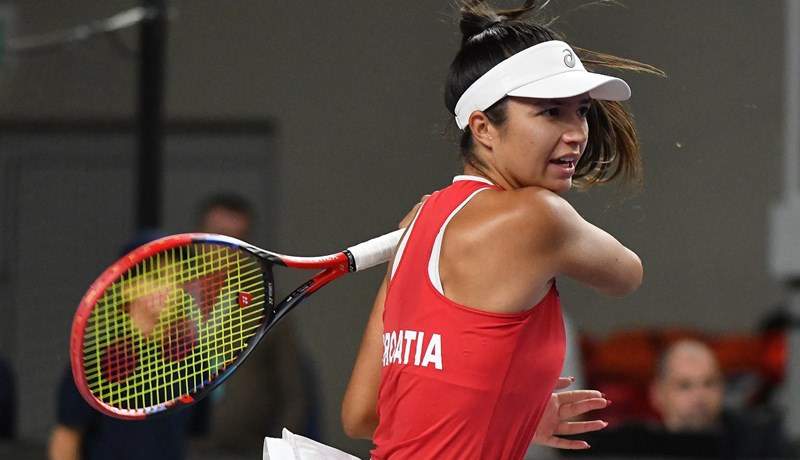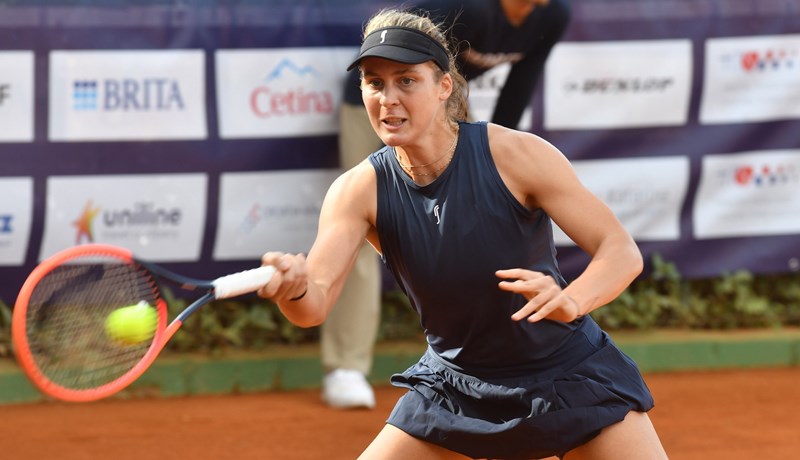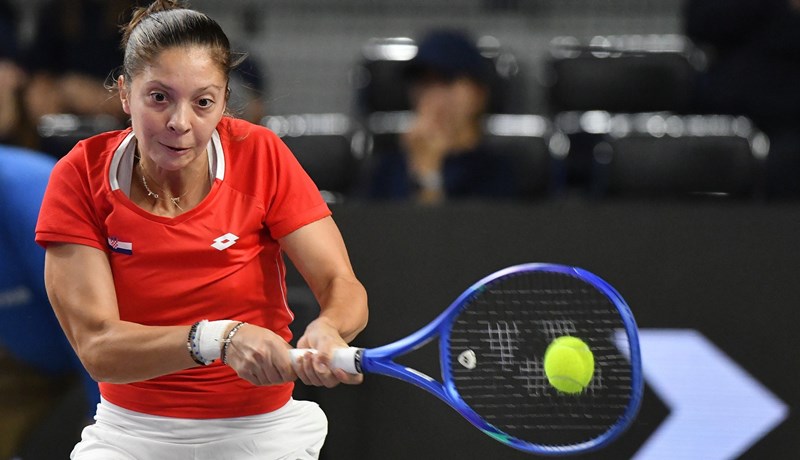Ženski tenis
Wimbledon 2018 Highlights: Kerber vs. Kasatkina includes epic 25-shot rally
https://www.youtube.com/watch?v=BaxI06ghOtE
ENGLESKA
The Sun: .. „Angelique Kerber dolazi iz Njemačke, gdje su pričati priče drugačije morala doživjeti da Serena sportašica plemstva i dvije stvarne duchesses okupilo oko kraljice središnjem terenu na njihovom povratku na tron ??godinu dana nakon rođenja No, nakon zaokreta poput braće Grimm, Kerber je negirao američku američku sreću. "
Mirror: „Anđeo širi svoja krila i omogućuje čekati Serena nakon pobjede Kerber pao na leđa njezina priča je da je borba nakon diže u 2016. samo na broju jedan, a zatim izgubio svoj oblik ...”
Daily Mail: „Kate, Meghan, Tiger Woods, Lewis Hamilton - bogati i slavni došao u Wimbledonu diviti konačan priču o sportaš majke Nažalost, za njih i za Serena Williams Još je nepozvana osoba gost. Angelique Kerber skinula sa šampanjcem i imati cijeli slavlje razmažen. Kerber je tip igrača koji je parkirao autobus na početku. bila je vrlo zaslužila pobjednika. "
Daily Star: „Kerber uništava srca svih onih koji vjeruju u bajke koje predlaže Mama Serena Williams u 65 minuta ništa u sportu je tako lijepa, kao dobar povratnički priča, nažalost, Serena nije mogla pogoditi poput ... stari prvak. Vojvotkinja od Cambridgea i Sussex, golfer Tiger Woods i formula 1 zvijezda Lewis Hamilton nada za čudo. Ali Kerber ostao hladan kao led. "
Telegraph :. „Wimbledon san‘mama-leđa’od Serena Williams završila s konačnim porazom Majka, koja je htjela da igra za sve majke svijeta, izgubio u samo 65 minuta, Angelique Kerber igra često podcijenjeno igraju vaši potezi su rijetki .. puno snage i prednja strana dolazi poput tave, ali one noge! Kerber je krajnji putnik. "
The Times: „Pozornica je postavljena za Serena Williams' iz visokog društva hvaljenog povratka u Wimbledonu za svoju pobjedu kao prvi majke 38 godina, ali Angelique Kerber očito ne vjeruje u savršeno radnim scenarijima ...”
SAD
ESPN: „Serena Williams je prilično jednostavan put do finala Wimbledona Angelique Kerber je napravio siguran da je ovaj put došao do kraja ..”
New York Times: „Fokus je bio na povratku iz Serena Williams No Angelique Kerber povratak recite svijetu priču .. O ustrajnosti, prevladavanje slabosti razvijanjem snage i oko u Wimbledonu finalu protiv protivnika snimanje vrhunske snage i iskustva na njegov plan. "
Washington Post: „Serena Williams osvojila je svoj najveći, najteži razvijenu naslov: prvak žena ništa protiv Angelique Kerber, koja je veliki šampion, ali Kerber igrao samo protiv protivnika Williams igrao protiv mnogih od njih, uključujući vrijeme i .. priroda ".
ŠPANJOLSKA
Marca: „Kerber završili sanjao povratak od Serena i donosi All England Club ušutkati sve bili prisutni svjedok Serena stranku, ali je više puta udario u zid pod nazivom Angelique Kerber ...”
AS: „Kerber je za Williams veličina prevelika njemačkog trijumfirao na velika vrata u odnosu na teniskom kraljica, ona je stijena na trgu nakon Steffi Graf 1996, njemački tenis cvjeta opet. "
El Mundo Deportivo: „Serena je došla protiv čvrstog njemačkog zid ne Angelique Kerber piše natrag priču njemačkog tenisa ..”
FRANCUSKA
L'Equipe: „Kerber je bio protiv‘kraljica’od početka gladan Ove subote je bila nemilosrdno s preciznošću i uvjerenjem da svlada protivnika na pogreške ...”
Le Monde: „Angelique Kerber je ponovno na najvišoj razini s izvrsnom obrambenom izvedbe, njemački iskoristio greške svojih protivnika ..”
ITALIJA
Gazzetta dello Sport: „Angelique je natrag, Kerber samo savršena: skromni Serena Williams Rezultati 2016 bile zamagljene za Kerber Ali sad je pokazala snagu i hrabrost ...”
Corriere dello Sport: „Kerber, kraljica na Wimbledonu Angelique sazrio kasno, za razliku od ostalih igrača, ali je njihov talent je neosporan Ona je dizajniran savršen plan da se Serena na tron ??..”
Tuttosport: „Njemačka je osvojio Wimbledon nakon Steffi Graf Angelique Kerber je novi njemački kraljica tenisa, prije nego uporan Serena Williams prisiljen kapitulirati ..”
Corriere della Sera: „Serena Williams je igrao pustoš i pogriješio nakon što je drugi jedva kreće i loše, ali to je normalno - samo deset mjeseci, ona je donijela svoju kćer na svijetu Kerber je pravi nasljednik Steffi Graf ... "
La Repubblica: „Wimbledon govori njemački i lukove kako bi Angelique Kerber Serena Williams mora zadovoljiti drugim mjestom, što odgovara istinskom odnosu snaga na terenu ..”
ŠVICARSKA
Blick: "Novi Wimbledon Kraljica Angie!"
Neue Zürcher Zeitung: „Kerber javlja pjesme u Grafs Williams nije imao šanse u finalu ..”
AUSTRIJA
Kronen Zeitung: „Williams porazila Kerber je kraljica Wimbledona!”.
As for Kerber, I agree that she’s not purely a defensive player, but she’s not an aggressor, either—maybe “creative counterpuncher” is the best term for her. She reacts, but reacting and working with what your opponent gives you are fundamental parts of the game. Kerber manages to react artistically, always changing speeds, moving her opponent side to side and up and back, and finding the opening with her forehand. In that sense, she’s not an easy opponent for Serena, because she doesn’t give her pace, or a predictable ball, and she has the speed and anticipation to make Serena hit, as they say, one more ball.
That term is a cliché by now, but I think it explains why Kerber has now beaten Serena in two Grand Slam finals—the only woman to do that other than Venus Williams. Serena likes to finish points with ground strokes, but by getting those shots back, Kerber forces her to move forward and try to close at the net instead, something she’s not as comfortable doing. Or at least she’s not as comfortable doing it against Kerber, who has a deadly forehand passing shot.
It was a Kerber forehand pass that won the key point on Saturday—the point where the match appeared to be turning in Serena’s favor, but somehow didn’t. The score was 1-1 in the second set, with Kerber serving. Serena had started punctuating points with “Come on!”s; she had belted a passing shot directly at Kerber from point-blank range; and she had yelled at a ball after hitting a winning drop volley to go up 15-30.
Regarding Kerber, my big picture assertion—one I’ve stated repeatedly for years and especially so this fortnight—is that it’s time the world divorced itself from the idea that she is a defensive player. Simply not true.
Better yet to think of it this way: Kerber is a creator, masquerading as a counterpuncher. To be sure, her foot speed helps her track down all sorts of balls many others can’t get. Certainly she knows how to keep a point alive. But there’s a lot more nuance to her than that. When you add the fact that she’s lefty into the equation, the mix is something quite different than that of a retriever. Watch how good Kerber is at redirecting both the ball and the energy flow of a point—with height, with depth, with angle, with power, with spin. Watch how she’s able to shape points with her forehand in a number of creative ways.
A few key points showed just how relaxed Kerber was, and that she was playing the ball and the game, instead of feeling the tension that can accompany playing Serena’s staggering résumé.
In the second set, Serena served at 2-3, 15-40. Serena hit a superb, 95-M.P.H. wide-slice serve that pulled Kerber so far off the court that she could only hit a one-handed backhand return. In came Serena to crush a backhand volley crosscourt for a winner.
Sitting behind Serena in the press seats, it was easy to see that she was primed to make a big move and, as she has so often, will herself into the match. But on the next point, about to hit only the fourth shot of the rally, Kerber was pulled wide into her left alley by a crosscourt Serena backhand. Given Kerber’s tendencies and the score, Serena stayed to the left of the center mark, clearly expecting a crosscourt forehand. Instead, Kerber saw a big opening and lashed out with her trademark down-the-line forehand to go up 4-2.
Once Kerber went up 5-2, it was hard to believe she’d win the match on Serena’s serve. Serena held at love. So there was Kerber, seeking to close it out at 5-3. We all know how hard it is to serve out a set or a match—much less Wimbledon—versus anyone, much less Serena. And Kerber’s serve (she’s a natural righty, so her throwing motion is hardly natural) can sometimes shrivel. But on the first point of the game, Kerber directed a fine serve into Serena’s forehand, jamming her and winning the point.
Then, after Serena caught up to 30-30, Kerber fielded a deep return down the middle by hitting a half-volley forehand moonball crosscourt that just touched the line. Serena replied with a deep high drive of her own to Kerber’s forehand. As with the break point earlier in the set, it would have been tempting for Kerber to go crosscourt. But instead, she struck it down the line as calmly as if she were hitting with a friend on a Sunday morning at the park. It went for a winner.
And then, the match point. Kerber’s ad-court serve is often both predictable and weak—that classic lefty slice. Serena was really starting to lean on it, forcefully driving backhands. So what did Kerber do? She hit it right into the middle of the box. Unable to get out of the way of the ball, Serena put it in the net.
It all added up to a magnificent performance. With a third Grand Slam title, Kerber, at least as I see it, is a sure-fire inductee into the International Tennis Hall of Fame. That’s just part of her legacy. In certain ways, she reminds me of another late bloomer, Stan Wawrinka. Like Wawrinka, Kerber for years was a fine crusader. She’d win occasional titles at smaller events, nibble into the later stages of Slams, but hardly be taken seriously as a bonafide contender to win majors. And then, at 28, she earned two major titles in ’16 and has just taken another one. There is something quite pleasing about seeing diligence rewarded—more so than potential squandered (Exhibit A: Marat Safin).
Now the question is if Kerber can rack up even more majors. Very tough to determine. Save for those times when Serena has been the dominator, women’s tennis has been in such a state of flux for many years—lots of Slam winners who then don’t follow up and generate significant results. I’d love to see Kerber make a deep run at the US Open—maybe even a rematch versus Serena. Certainly her fitness and playing style will keep Kerber a contender at the Australian Open for several years. Roland Garros? Not so easy. As Simona Halep proved in winning their quarterfinal match there this year, Kerber is vulnerable versus slow, high balls.
And I think the mix of Kerber’s late arrival to these big titles and what you’ve dubbed her “creative counterpuncher” style will also endear her to the public.
Watching Kerber hold up the winner’s plate, I kept thinking back to her win in the second round, way out on Court 12, over 18-year-old Claire Liu. That was the day when the women’s draw was falling apart; by the middle of the week, six of the Top 8 seeds were gone, and by the end of Manic Monday the entire Top 10 was out. Which left Kerber as the highest seed at No. 11.
She could easily have gone out to Liu as well; the Californian is a hard hitter who won the girls’ event here last year. Kerber lost the first set, and struggled in the third. In the past, these were the types of matches where you’d see her react sarcastically to her opponent’s winners, slam balls down after her own misses, and generally act like the world was against her. Not this time. After one backhand winner in the third set, Kerber let out an “Auf ghet’s!”— “Come on!”—that was about as loud as anything I’d heard from her on a court. I remember thinking: “She knows she has an opportunity here.”
And she took it. She snuck past Liu 6-4 in the third, and didn’t drop another set in the tournament. She knocked out four young WTA hopefuls—Naomi Osaka, Belinda Bencic, Daria Kasatkina and Jelena Ostapenko—along the way, and she kept digging herself out of close sets that she looked destined to lose. Kerber absorbed the best they had to offer—which, in Kasatkina’s case, was a lot—while always remaining calm. It was as if she knew, at 30 years old, having been No. 1, having reached a Wimbledon final, that her more-mature game would prevail in the end. The most amazing thing is that she acted exactly the same way against Serena.
As for her future, Kerber may never be dominant. As we’ve noted here, she reacts to what her opponents are doing, rather than taking control of a match herself—that means she can be overpowered. And while she was calm through this fortnight, Kerber will get frustrated again. Kevin Anderson aside, players are rarely able to remodel their personalities in the middle of their careers. But Kerber will be in the Slam mix. For now, it’s just good to see her fulfill her potential, because she’s a subtly brilliant and beautiful player to watch. (Steve Tignor and Joel Drucker)
Angelique Kerber is deceptively diabolical, an adroit weaver of spider webs who builds her points not just with foot speed and consistency, but also with the ability to create disturbing patterns—angles, depth, drop shots, the rare but occasionally useful excellent serve and, most implicating of all, that rapier-like lefty forehand that can go crosscourt early and flat or down the line with a beguiling troika of a delayed swing, ample pace and even a scintilla of that long-forgotten spice, sidespin.
Don’t ever let Kerber’s swift feet fool you into thinking she is primarily a defensive player.
---------
You have to give huge credit to Kerber. Holy mackerel, what a great athlete she is and what a clever player too. She knew that moving Serena around the court would be her best chance and she carried out that game plan perfectly. She knew that the longer the rally went on the greater her chance of winning the point.
Kerber’s movement was superb. She has great footwork and demonstrated what an advantage it is to get into position to play your shots. There were times when she got so low on her legs on the baseline that you almost thought she was praying. Her serve is a useful weapon too and I like the fact that she’s added aggression to her game.
--------------
Serena's unforced errors throughout Wimbledon:
19 (3R)
11 (4R)
9 (QF)
7 (SF)
24 (F) --- plays against Kerber
Let's look at Jelena Ostapenko:
16 (3R)
15 (4R)
28 (QF)
36 (SF) --- plays against Kerber
Let's look at Daria Kasatkina:
16 (2R)
17 (3R)
17 (4R)
31 (QF) --- plays against Kerber
Let's look at Belinda Bencic:
15 (1R)
16 (2R)
18 (3R)
36 (4R) --- plays against, guess who? Kerber!
It is amazing how Ange makes her opponents make mistakes.
--------
Most career Grand Slam titles among active women's players:
Serena






















Venus






Sharapova




Kerber


Azarenka

---------
Kuznetsova

Kvitova

Muguruza

---
Now, 22 years later, Kerber has given Germany another women’s singles champion at Wimbledon and also given her nation a sporting lift.
“After a really embarrassing World Cup, we needed something,” said Boris Becker, the former Wimbledon men’s champion from Germany, in comments to the BBC.
Kerber, who will rise to No. 4 on Monday, can absorb pace as well as anyone in tennis. She put 87 percent of her returns in play in the tournament and put a remarkable 80 percent in play against Williams, whose other opponents could manage to return less than 60 percent.
With her improved serve, Kerber also held firm in the second set when Williams, true to her past, got tougher, increasing the volume of her grunts and her intensity.
“This is Serena; I know that this is the point she is always doing this, because this is a part of her game,” Kerber said.
At 1-1 in the second set on the first point of Kerber’s service game, Williams pounded a forehand swing volley straight at Kerber when both were at the net. It sailed long as Kerber avoided it.
“I think Angie reacted well on it,” her coach, Wim Fissette, said. “She didn’t take it personal or she was not irritated by it, just continued to play her game and focus just on herself.”
Kerber made only five unforced errors in the match. But she was also bold when she had to be on the grass that suits her flat strokes and taste for low-bouncing balls.
“I feel Angie started the tournament a bit slow and more with her older game, with just running and fighting,” Fissette said. “And after the second round she decided that, ‘With this tennis, I’m not going to win. So I have to play my offensive tennis, especially when I need it.’”
Against Williams, she won the first set with her signature shot: a forehand winner down the line. And when Kerber served for the match, Williams threw up a high defensive shot at 30-30 that landed deep, a shot that required Kerber to generate the pace. She did not shrink from the responsibility. She coolly nailed another forehand down the line that landed on the opposite baseline with a puff of chalk for another winner.
When Williams lost the next point, the final point, with a backhand return into the net, Kerber dropped her racket, pitched forward onto her knees and began to cry as she lay on the grass and the dirt.
She and Williams soon met on Kerber’s side of the net for an extended embrace.
This is becoming a Grand Slam tradition, this contrast of styles. And Kerber has now won two of their three duels in major finals: defeating Williams in the 2016 Australian Open final, losing to Williams in the 2016 Wimbledon final and winning on Saturday.
Kerber, who also won the United States Open in 2016, owns titles at three of the four Grand Slam events, lacking only the French Open.
Williams has won all four majors at least three times, but, for now, her total remains at 23 — one short of Court’s record.
“It’s a huge thing for her, coming back after the last few months to being in the final,” Kerber said. “For sure she was trying to do everything to beat me today, but I’m sure she will take her next Grand Slam and she will make history for sure.”
Fissette, who has now coached five players who have beaten Williams, said he felt her relatively easy draw, in which she faced no seeded players in the first five rounds, might have made it difficult for her to find the necessary gear on Saturday.
“I feel she just missed experience in matches against a really top player who is rock solid, like Angie,” Fissette said.
LONDON, Great Britain - Angelique Kerber's coach Wim Fissette has told wtatennis.com how the Wimbledon champion was "hurt" by the slew of "negative comments" about her when her form and ranking spiralled last season.
In an exclusive interview, Fissette said the criticism of Kerber's performances in 2017, when she fell out of the Top 20, had fueled the German's desire to show everyone in the sport that she could once again be a force at the top of the game. There can now be no doubt of Kerber's enduring class after she defeated Serena Williams in straight sets to win the Venus Rosewater Dish for the first time, blocking the American's attempt to equal Margaret Court's all-time record of 24 majors.
"This means more to Angie than her first two Grand Slam titles, as 2017 was a very tough year for her. The pressure was really high and she saw a lot of negative comments about her and that hurt her. She felt hurt about that," Fissette said after Kerber added to the two majors she won in 2016, at the Australian and US Opens. "That was really difficult for her and she really had the desire to be at her best again, and to show everyone what a good player she is."
Fissette spoke of his delight at how poised and composed Kerber had been on Centre Court. "Wimbledon is the biggest tournament in the world for her, and it's the tournament she absolutely wanted to win. And she was playing against the best player ever. So for her to stay calm like this, it was a big surprise," said Fissette.
"But I had a really good feeling before the match. I felt that in the past few days that she had been really focused and she had come through some tough matches, including in her semifinal against [Jelena] Ostapenko, who like Serena is also a hard-hitter. I also felt as though Angie was really challenged in the matches she had had before the final, while maybe Serena hadn't been so much. And Serena was maybe missing those challenges.
"We are all staying in the same house and when I saw Angie on the morning of the match she surprised me because she was so relaxed. And when we spoke, she spoke to me with a lot of belief that she could do it today. All day, like when we were hitting, she looked very convinced that she could do it. In the morning, she looked good and really ready."
In Fissette's analysis, it helped that Kerber had already beaten Williams in a Grand Slam final, and he said his player had drawn on those experiences from Melbourne Park. "Of course, she learned from that match in Australia. Playing in your first Grand Slam final and winning it, that's an amazing effort. Not many players can do that so it showed that she really can be at her best in the biggest matches. That's a huge quality. The more you are in those situations, the more it helps you to stay calm."
Now Kerber is just a French Open title from accomplishing the mythical Career Grand Slam, and Fissette suggested that in 2019 she will have a new belief in her clay-court game. "I think Angie did really well on clay this year. We worked really hard on the clay to give her a clear game-plan and to make her believe that she can do well. I think she made a huge step this year. She beat some really good clay court players. And she found the game that allows her to be successful," he said.
"Next year, she is going to continue that plan, and in 2019, for the first time in her life, she will start the clay-court season with some belief. She's going to be thinking, 'you know what, I can also do it on the clay' and that's going to be great. Angie likes to have good memories on courts. When she comes on Centre Court at Wimbledon, she has good memories. She plays with a feeling. It's the same when she plays at the Australian Open. She doesn't have those good feelings at the French Open yet."
Fissette believes Williams, who was playing only her fourth tournament since returning from maternity leave, will still reach 24 majors. "I think Serena can. Even today, the level she was playing at in some moments was incredible. She was still serving big and returning big and her shots were there. I think her movement is also improving. But today I saw that Serena was missing having not played in really big matches," said Fissette.
"She didn't get challenged in Paris or in Wimbledon before the final, by the best players in the world. She hadn't really been in those tough situations. I feel that's something she's missing right now. But her game is still there and she's going to win her 24th Grand Slam."
Kerber in die Hall of Fame?
Dafür winkt Kerber nach dem Gewinn ihres dritten Grand Slam-Titels ein anderes Zückerchen. Die International Tennis Hall of Fame in Newport im US-Bundesstaat Rhode Island hat vor rund einem Jahr die Richtlinien geändert. Spieler und Spielerinnen, die im Einzel 3 Grand-Slam-Turniere gewonnen haben und mindestens 13 Wochen die Nummer eins der Welt waren, oder fünf Grand-Slam-Turniere gewonnen haben, werden automatisch nominiert. Ob der Spieler schließlich aufgenommen wird, liegt dann immer noch an der Entscheidung des Wahlkomitees.
Kerber hätte nach ihrem Karriereende demnach gute Chancen, in die Hall of Fame aufgenommen zu werden. Neben den drei Titelgewinnen bei Grand Slams stehen nämlich auch 34 Wochen auf Platz eins Weltrangliste zu Buche (von September 2016 bis Januar 2017 für 20 Wochen, von März 2017 bis April 2017 für 5 Wochen und von Mai 2017 bis Juli 2017 für 9 Wochen).
Eine weitere Form, Kerbers Leistungen zu ehren, schlägt der für den Haushalt und Finanzen zuständige Vizepräsident des DTB, Dieter Göken, vor: Eine „Angelique-Kerber-Straße“ in Bremen, ihrem Geburtsort.
Kako je Anđelija postala ljevakinja?
Kao curica kopirala je sve što radi trener na drugoj strani. On je igrao desnom rukom, a njoj je to bilo na lijevoj strani i stoga je uzela reket u lijevu ruku. Sve drugo radi desnom rukom.
„Ich spiele nur mit links Tennis, mache sonst alles mit rechts. Als Kind stand der Trainer ja gegenüber von mir. Da habe ich es so gemacht wie er. Bei mir war es dann eben links, was bei ihm rechts war.“
S djevojkom, ženom ili prijateljicom ne razgovara se preko sportskoga foruma. To je malo nastrano. I ne vidim da je išta čudno što se na potforumu posvećenomu ženskomu tenisu piše o tenisačici koja u finalima GS-a jedina u povijesti ima pozitivni omjer sa Serenom.
P. S.
Ne vidim baš da si pohvalio Petrin ulazak u finale...
- Najnovije
- Najčitanije
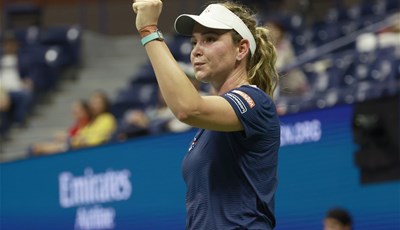
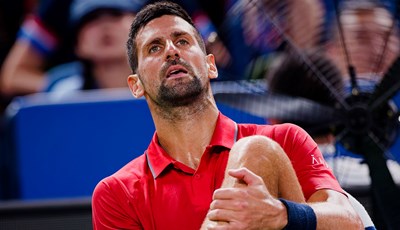
Đoković će se za Australian Open pripremati na turniru kojega je osvojio dva puta dosad
3 sata•Australian Open
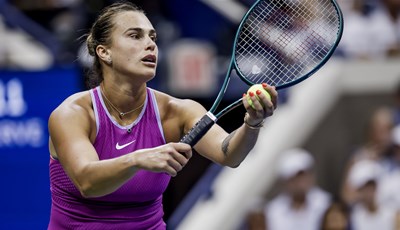
Arina Sabalenka drugu godinu zaredom izabrana za tenisačicu godine
14 sati•WTA Tour
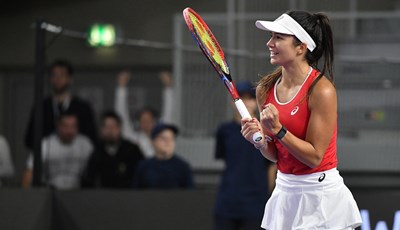
Marčinko nakon odlične sezone: 'Puno se toga promijenilo nabolje'
1 dan•WTA Tour
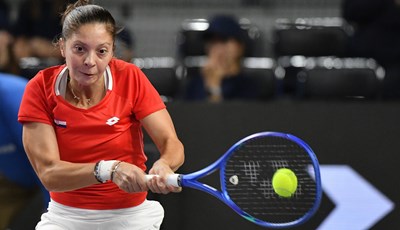
Ekspresan kraj za Antoniju Ružić, prva nositeljica prepustila joj samo gem
3 dana•WTA Tour
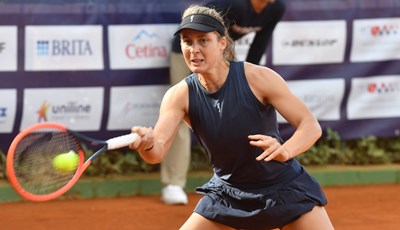
Tara Würth poražena u dva seta u četvrtfinalu turnira u Egiptu
3 dana•WTA Tour

Tara Würth nakon velike borbe prošla u četvrtfinale turnira u Egiptu
4 dana•WTA Tour

Antonia Ružić ispustila samo tri gema na putu do četvrtfinala turnira u Limogesu
4 dana•WTA Tour
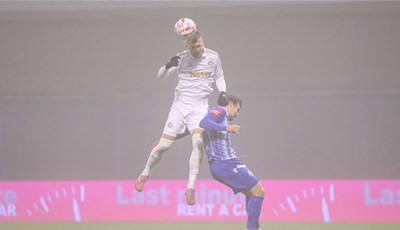
Šitum: 'Rebićev lakat? Situacija je jasna, tko god je igrao nogomet zna da je to prekršaj'
19 sati•Nogomet

Bomba iz Italije, milanski Inter želi još jednog dinamovca i to već u siječnju
5 sati•Nogomet

Jagušić: 'Vidim se u Belupu i nakon ove polusezone, a što reći o Dinamu? Takva ekipa te kazni'
22 sata•Nogomet

Modrić dobiva pojačanje u napadu? Milan bacio oko na njemačkog centarfora
4 sata•Nogomet

U Osijeku se nije proslavio, a Fabrizio Romano piše da ga sada prate europski velikani
20 sati•Nogomet
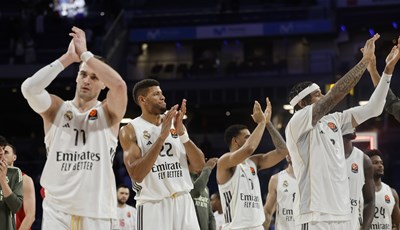
Hezonjin Real Madrid na teškom ispitu u Milanu hvata devetu vezanu pobjedu
47 min•Košarka

Vrijeme je za Kup kralja: Valencia na nezgodnom ispitu kod drugoligaša u šesnaestini finala
3 sata•Nogomet
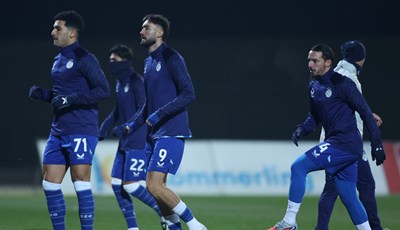
Dinamo bez važnog dvojca protiv Lokosa, Istra 1961 bez Lawala, a na AFCON idu dva člana Kustošije!
6 sati•Nogomet




